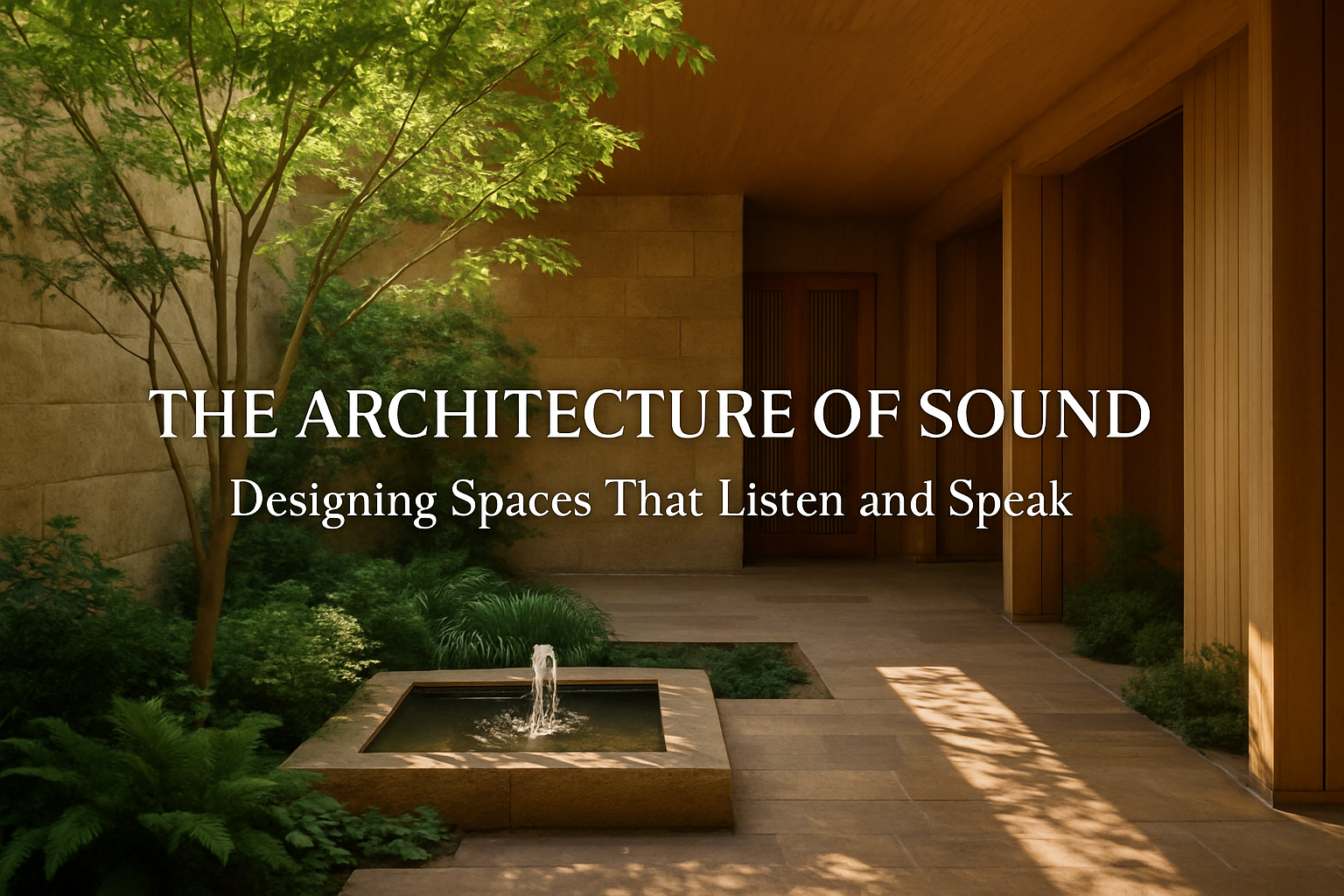Sensory Architecture Series: Sound
The Architecture of Sound: Designing Spaces That Listen and Speak
We often think of architecture as visual — a play of light, shadow, texture, and form. But a space is never experienced in silence. The way it sounds, and the way it holds sound, profoundly shapes how we feel. Sound is a spatial material. It is vibration and echo, rhythm and resonance — yet too often, architecture forgets the ear.
In the age of hyper-visuality, architecture has been seduced by image: renders that shine, facades that pop, photos that go viral. But good buildings are not just seen — they are heard. They whisper or murmur, hum or hush, and occasionally, they roar.
Sound is Spatial
Imagine walking into a cathedral: the way your footsteps echo off the stone; how every cough or whisper stretches into the vaulted air. Now contrast that with the close quiet of a carpeted reading room, or the gentle acoustics of a wooden cabin, where every creak of the floorboard feels intimate.
Sound describes space. It tells us how big or small a place is. Whether it is enclosed or open, hard or soft, reverent or informal. In this way, sound is not a by-product of design — it is design. It shapes our emotional response long before we realise it.
Quiet Is Not the Absence of Sound
Designing for sound is not about removing noise — it is about crafting the right kind of quiet. Silence can be sterile, oppressive, even unnerving. What we seek instead is a soft quiet, a natural quiet — the gentle presence of background sounds that make a space feel alive without overwhelming us.
The rustle of leaves outside a hospital window. The muffled clink of cups in a café. The trickle of water in a courtyard. These are not distractions — they are invitations. They root us in place, remind us we are part of the world.
Everyday Examples of Architectural Acoustics
Libraries: The best libraries are not silent — they are softly murmuring. Designers use absorbent materials, low ceilings, and spatial zoning to shape this hushed, concentrated soundscape.
Cafés and restaurants: The buzz of voices creates ambience, but if the room echoes or booms, conversation becomes strained. Timber linings, booth seating, and low-hung lights often help moderate the noise.
Schools: In education settings, reducing noise reduces stress. Ceiling baffles, wall panels, and acoustic zoning are essential to allow focus, creativity, and calm.
Natural courtyards and gardens: These are not just visual breaks — they offer auditory relief. Open air, birdsong, moving leaves and distant footsteps offer a soothing counterpoint to urban density.
Designing Emotionally with Sound
Sound affects physiology. A well-tuned acoustic environment can lower our heart rate, reduce cortisol, and improve concentration. Conversely, harsh sounds — constant HVAC hums, traffic, echoing corridors — heighten stress and fatigue.
Designing for sound is therefore designing for emotion. It is about evoking the right state of mind: comfort, focus, awe, intimacy, reflection. This is not technical detail; it is foundational to human-centred design.
The Acoustic Palette
As with visual materials, every element in a building contributes to its sound.
Hard surfaces (glass, stone, concrete) reflect sound — useful in some cases, but often too harsh.
Soft surfaces (fabrics, timber, acoustic panels) absorb or diffuse sound, softening the environment.
Natural materials like wool, felt, cork, and even thick curtains help dampen excess noise while adding warmth.
Architectural forms such as curves, alcoves, double-height spaces, or layered wall assemblies can shape how sound moves and where it lingers.
Sound can also be deliberately introduced: water features, subtle background music, openable windows that let in birdsong or ocean breezes.
Soundscapes and Identity
Every place has a soundprint — a unique fingerprint made of vibrations. Think of the calls of a market square, the hush of a Japanese onsen, or the echo of footsteps in a historic train station. These soundscapes tell us something about culture, pace, time, and place.
In biophilic and soulful architecture, sound is not generic. It is of the place. We might design a coastal retreat to invite the wind and gulls in. A forest home to filter rain through the trees. A city apartment to allow a quiet murmur of street life — not shut it out entirely.
Good architecture listens. It learns the local rhythm and responds with care.
An Invitation to Design for the Ear
To design sensory architecture is to engage all the senses — not just the eye. When we tune into sound, we begin to notice how often it is overlooked, and how profound its absence or presence can be. We shift from treating acoustics as a technical afterthought to embracing sound as a creative material.
In a world that grows louder and more chaotic, offering a place of thoughtful sound — or gentle quiet — is an act of generosity.
Let us design spaces that do not merely look beautiful, but that sound right too. Spaces that listen as much as they speak.
